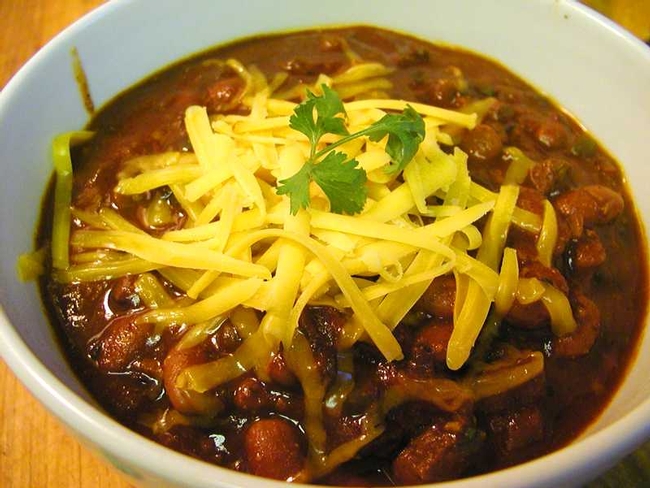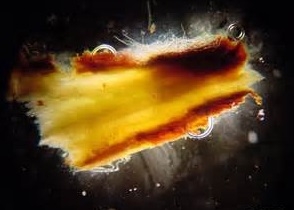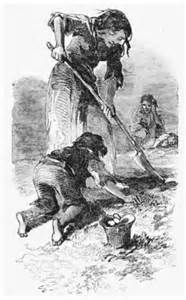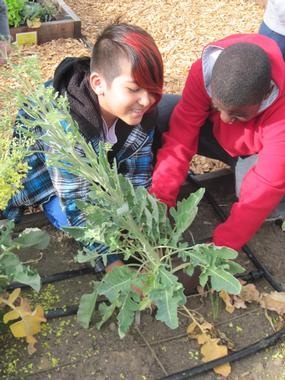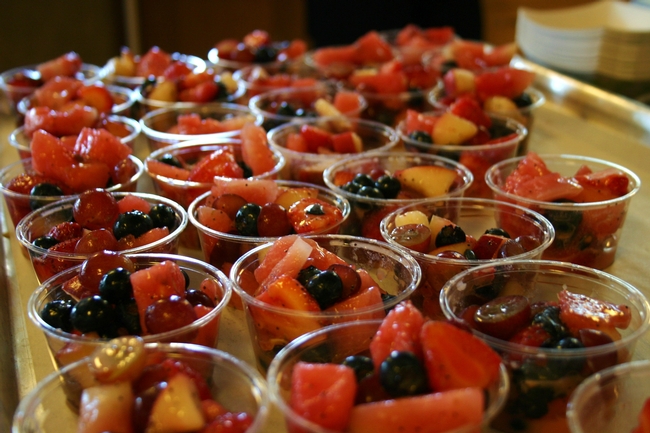UC Food and Agriculture Blogs
A souper bowl of chili
If it's Super Bowl time (and it is on Sunday, Feb. 1, when the Seattle Seahawks and the New England Patriots clash for the National Football League championship), it's also time for a "Souper Bowl."
A souper bowl of chili, that is.
Question is, which recipe to prepare? Well, the Solano County 4-H Youth Development Program to the rescue.
Every year the Solano County 4-H Project Skills Day includes a Solano County 4-H Chili Cookoff. Teams sign up, prepare their chili in advance, and transport it in a crockpot or slow cooker to the venue (this year it was the C. A. Jacobs Middle School in Dixon). They field questions from the judges, who sample it, score it and select the winning team.
This year's winner was a pepper-loving team that used four different kinds of peppers and the secret ingredient — love.
The group, all members of the Dixon Ridge 4-H Club and enrolled in the countywide Outdoor Cooking Project, chose Pasilla, Serrano, Anaheim and green bell peppers and also displayed "specimens" in front of their crockpot.
Team members Quincy and Fallon Decious and Shaley and Braydon Gish said they plan to make the chili for their families on Super Bowl Sunday. “It's really good,” they all agreed.
While preparing the peppers, they said they wore “doctor gloves” to prevent the potent pepper oils from reaching their skin.
The judges praised the flavor and texture, the display and their enthusiasm. Judges were Cutter Hicks, reporter with the Dixon Tribune; Jim Nessen of Dixon, who works for a data company in Sacramento, and Kathy Keatley Garvey, a University of California, Davis employee and a longtime 4-H volunteer and food columnist.
Valerie Williams, Solano County 4-H Program representative, said the cookoff competition teaches the participants public speaking as well as cooking and presentation skills.
“Public speaking has been a cornerstone of the 4-H Youth Development Program,” she said. “Public speaking skills are ranked No. 1 among the skill sets of professionals.” Youths participating in the Project Skills Day “develop many life skills, including public speaking, organizing ideas, and creating and using graphics, resulting in increased self-esteem and confidence.”
Four teams competed in the annual cookoff. Others were:
- Los Chileros, Pleasants Valley 4-H Club, Vacaville, comprised of Gracie O'Dell, Randy Marley and Justin Means
- Chuck and the Three Frijolitos of Pleasants Valley 4-H Club, comprised of -Anna and Charlotte Kent and Sheridan Parks
- The Chili Dogs, Suisun Valley 4-H Club, comprised of Xavier Copeland, Christopher Lang, and Robert and Clairese Wright.
The Los Chileros used both pork and beef and fire-roasted peppers. Another addition was corn, for a southwestern-style chili.
Chuck and the Three Frijolitos' recipe opted for beef stew meat and three different kinds of beans: pinto, black and kidney.
The Chili Dogs' key ingredients were hot dogs and carrots. Each wore a t-shirt with an image and name of their family dog. They made biscuit-shaped rolls to accompany their chili.
The winning recipe:
Outdoor Cooking Project
By Fallon and Quincy Decious, and Brayden and Shaley Gish
Dixon Ridge 4-H Club, Countywide Outdoor Cooking Project
2 pounds of pork shoulder, cut in 1/2-inch chunks
2 pounds ground beef
Olive oil (as needed to brown meat)
2 cans of tomatoes, chopped or diced
2 cans of beans, one kidney and one pinto, drained
2 Pasilla peppers
2 Serrano peppers
2 Anaheim peppers
2 green bell peppers
2 onions
2 cloves garlic
Water, approximately 1 cup
Cornstarch
Seasonings to taste: Beef boullion, chili powder, ground cumin, garlic salt, black pepper, paprika
In a large stock pot, brown pork in the olive oil. Add the ground beef and continue cooking over high heat until beef is browned, about 30 minutes. Add the water and seasons. Cook an additional 30 minutes. Add tomatoes and beans. Turn down beef and simmer for 30 minutes. While mixture is simmering, coarsely chop onions and peppers and finely copped garlic. Add these to the pot and continue cooking until pork is tender, about another 30 to 45 minutes. Check flavor and add seasonings to taste. If needed, thicken chili with cornstarch.
Here's another recipe to try that the judges favored for the flavor:
Los Chileros
By Randy Marley, Justin Means and Gracie O'Dell
Pleasants Valley 4-H Club, Vacaville
Three 15-ounce cans of tomatoes
One 15-ounce can of corn
One 15-ounce can of black beans
One 15-ounce can of kidney beans
One six-ounce can of tomato paste
2 green bell peppers
2 Pasilla peppers
1 to 2 jalapeno peppers, depending on taste
2 Anaheim peppers
2 onions
1 to 4 stems of cilantro
3 pounds steak
A half pound of pork sausage
2 tablespoons chicken stock powder
1 tablespoon chili powder
1 teaspoon cumin
1 tablespoon garlic
4-ounce package of chili spices
Salt and pepper to taste
The ingredients "can be adjusted to suit your taste," they said.
Brown meat in a skillet and then put in crock pot. Cut vegetables and add to crock pot. Add spices and canned tomatoes and paste. Cook on high for six hours. Add the corn and beans the last 30 to 45 minutes.
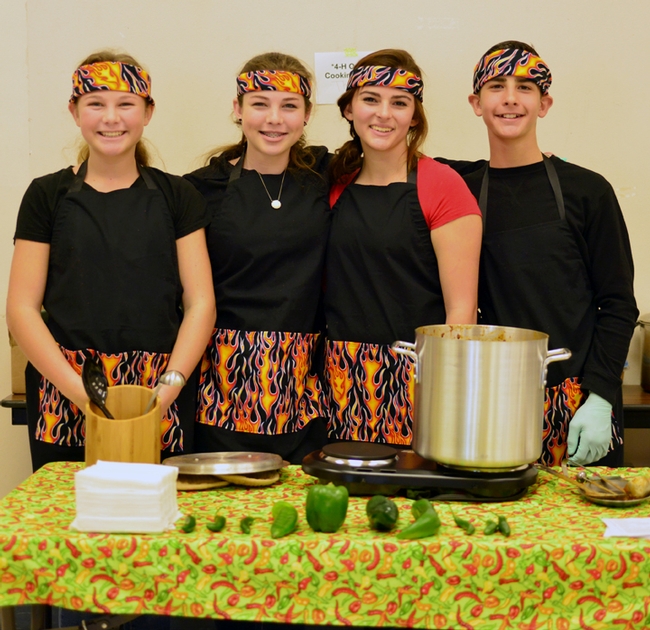
The winning chili team at the 2015 Solano County 4-H Chili Cookoff is this group of Dixon Ridge 4-H Club members who are enrolled in the countywide Outdoor Cooking Project. From left are Quincy Decious, Fallon Decious, Shayley Gish and Braydon Gish. (Photo by Kathy Keatley Garvey)
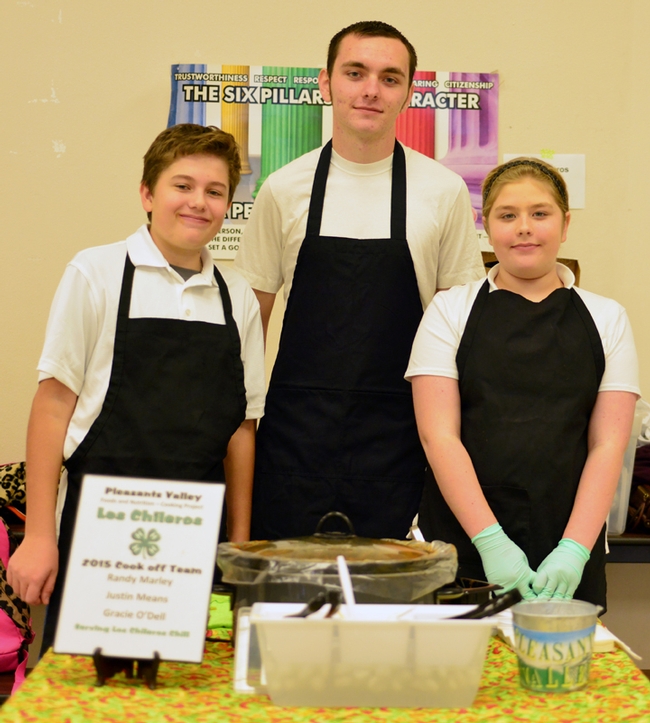
The Los Chilerios team from Pleasants Valley 4-H Club, Vacaville, made a very good chili at the Solano County 4-H Chili Cookoff, the judges agreed. From left are Justin Means, Randy Marley and Gracie O’Dell. (Photo by Kathy Keatley Garvey)
Sustainable food systems depend on healthy plants
Discolored leaves. Decaying roots. Dead wood. Mother Nature offers a fascinating and colorful backdrop of clues to track microscopic killers. Much like any medical mystery, experts are called in to diagnose or identify a disease from its symptoms and recommend management strategies to prevent further damage or loss of healthy plants.
In the world of crop science mysteries, plant pathology solves the crime. The usual suspects include bacteria, fungi and viruses.
Humans and animals depend on plants for their food supply and ultimately for their survival. When diseases threaten crops, a high-quality, affordable food supply is placed at risk. For growers, plant diseases can reduce crop yields. For consumers, reduced crop yields can drive higher food prices. Plant pathology research holds enormous implications for a sustainable food supply.
Florent Trouillas, who was named UC Cooperative Extension specialist in the Department of Plant Pathology at UC Davis and the Kearney Agricultural Research and Extension Center last year, explains the bottom line of most concern to growers.
"Once we identify a disease causal agent, a main question remains from growers. What growers really want to know is how to control the disease and prevent its spread to new healthy plants; they look to the University of California for solutions," Trouillas said.
A crisis in the food production system can impact other areas of society as well. In fact, history is filled with examples of how plant diseases influenced economies, environments and human societies.
Trouillas cites one of the most well-known examples in plant pathology: the Great Famine. Millions of Irish immigrants relocated to the United States in the mid-1800s after a terrible potato blight led to widespread starvation in Ireland. Experiments conducted in 1861 by Anton deBary, considered to be one of the founding fathers of plant pathology, proved the blight was caused by a fungus, which we now know is an oomycete. This plant disease had a direct impact on the Irish society with a subsequent Irish immigration wave into America.
Another historical illustration of plant pathology research occurred in the 1920s. The most common trees in the forests of the United States at the turn of the century were the majestic American chestnuts. The trees generated income for humans and the timber industry, served as a food source for people and animals, and provided habitat for wildlife. Then the trees started dying, until by the late 1920s, they had become the first tree in modern times on the brink of extinction. Plant pathologists were particularly adept at identifying plant diseases by this time and diagnosed the Cryphonectria parasitica fungus as the cause of the chestnut blight. By preventing the extinction of the pivotal species, plant pathology had a direct impact on the economy and the environment.
More recent major plant disease outbreaks in the United States involving plant pathology research have included Sudden Oak Death with devastating effects in California and Oregon forests, pitch canker killing California native pine species, and citrus canker in Florida, which has had a huge economic impact on the industry.
Veterinarians treat diseases in animals, physicians in humans. Trouillas describes the role of plant pathologists in similar terms. “We study the pathology of plant systems. Plant pathologists treat plants," he said.
Healthy plants ensure a sustainable food source and habitat for so many other organisms, including the human species.
Shaping Healthy Choices combines approaches to make a lasting impression on kids
You can lead a child to fresh fruits and vegetables, but how do you entice them to eat healthful foods when you aren't watching?
“Simply offering healthy options is not enough to motivate children to make healthy choices,” said Sheri Zidenberg-Cherr, UC Cooperative Extension specialist in the Department of Nutrition at UC Davis.
“Moreover, imposing restrictions rather than providing children with options to make healthy choices can have long-term negative effects,” said Rachel Scherr, assistant project scientist, also in the UC Davis Department of Nutrition.
In 2012, more than one-third of children in the U.S. were overweight or obese, according to the Centers for Disease Control and Prevention. Studies have shown that obese children are more likely to be obese as adults, increasing their risk for health problems including heart disease, type 2 diabetes, stroke, cancer and osteoarthritis. To target the complex issue of eating habits, Zidenberg-Cherr and her UC Cooperative Extension and UC Davis colleagues designed a school-based program and tested it in Sacramento and Stanislaus counties through the leadership of UCCE nutrition, family and consumer science advisors Terri Spezzano and Yvonne Nicholson.
“Parents shared with me that their children are voicing input on meals and asking if they can add fruit to their salads,” a participating teacher told the researchers.
During the first year that the Shaping Healthy Choices Program was implemented in Sacramento County schools, the number of children classified as overweight or obese dropped from 56 percent to 38 percent. The participating students also improved their nutrition knowledge, ability to identify different kinds of vegetables and amounts of vegetables that they reported eating.
“I tried zucchini and yellow squash when I was little and didn't like it, but now I tried it and I love it!” said a 9-year-old student.
The Shaping Healthy Choices Program takes a multifaceted approach, combining nutrition education with family and community partnerships, regional agriculture, foods available on school campus and school wellness policies.
The garden-enhanced, inquiry-based nutrition curriculum was developed by Jessica Linnell, a doctoral candidate in the Graduate Group in Nutritional Biology; Carol Hillhouse, the School Garden Program director at the Agricultural Sustainability Institute; and Martin Smith, a UCCE specialist in the Departments of Human Ecology and Population Health and Reproduction. The family and community partnerships featuring family newsletters were developed by Carolyn Sutter, a graduate student in the Graduate Group of Human Development, and Lenna Ontai, a UCCE specialist in the Department of Human Ecology. Lori Nguyen, a doctoral candidate in the Graduate Group in Nutritional Biology, Sheridan Miyamoto, postdoctoral scholar in the Betty Irene Moore School of Nursing, and Heather Young, dean of the Betty Irene Moore School of Nursing, organized community-sponsored health fairs.
Gail Feenstra, deputy director and food systems analyst for the UC Agricultural Sustainability Institute, helped the schools set up systems to add fresh, locally grown produce to their menus. Jacqueline Bergman, a postdoctoral scholar in the Department of Nutrition, coordinated school-site specific wellness committees.
The UC Cooperative Extension and UC Davis team worked with classrooms to use Discovering Healthy Choices, a standards-based curriculum that incorporates interactive classroom nutrition, garden and physical activity education for upper elementary school students. Teachers partnered with UCCE to incorporate cooking demonstrations to show the connections between agriculture, food preparation and nutrition. To reinforce the lessons at home, Team Up for Families – monthly newsletters containing nutrition tips for the parents – were sent home with the students. School Nutrition Services purchased fruits and vegetables from regional growers and distributors to set up salad bars and prepare dishes made with fresh produce. The Shaping Healthy Choices Program activities were integrated into the school wellness initiatives.
“My students shared things they learned about safe food handling and safety in cooking,” said a teacher who participated in the study. “Parents said their children want to help in preparing meals at home.”
“My daughter is more interested in trying new foods and eating more fruits and vegetables,” reported one parent. “She often surprises the family by making a surprise salad snack for everyone.”
Preliminary analysis shows that nine months after the classroom education ended, the decrease in the students' body mass index percentiles, or BMI percentiles, was sustained. “This is a big deal,” said Zidenberg-Cherr, while cautiously encouraged by the program's success. “We are in the process of analyzing several aspects of the program — the data set is so complex and I have to feel 100 percent confident in our statements.”
Through a partnership with UC CalFresh, the researchers have expanded the comprehensive program to schools in Placer, Butte and San Luis Obispo counties. Determining feasibility for expansion of the program for broader dissemination is planned for the 2015-2016 school year.
This project was funded by grants from the UC Division of Agriculture and Natural Resources and the U.S. Department of Agriculture.
The University of California Global Food Initiative aims to put the world on a path to sustainably and nutritiously feed itself. By building on existing efforts and creating new collaborations among UC's 10 campuses, affiliated national laboratories and the Division of Agriculture and Natural Resources, the initiative will develop and export solutions for food security, health and sustainability throughout California, the United States and the world.
Asian Citrus Psyllid is Spreading in California
[From the December 2014 issue of the UC IPM Green Bulletin] In August 2012, we wrote about the Asian citrus psyllid (ACP) in UC IPM's Green Bulletin newsletter. At that time, ACP was found only in San Diego, Imperial, Riverside, San Bernardino, Los...
Victorian Box Decline
[From the December 2014 issue of the UC IPM Green Bulletin] Victorian box (Pittosporum undulatum) is an evergreen tree native to Australia that grows moderately fast to about 50 feet high and wide. It was much planted as an ornamental landscape subject...



